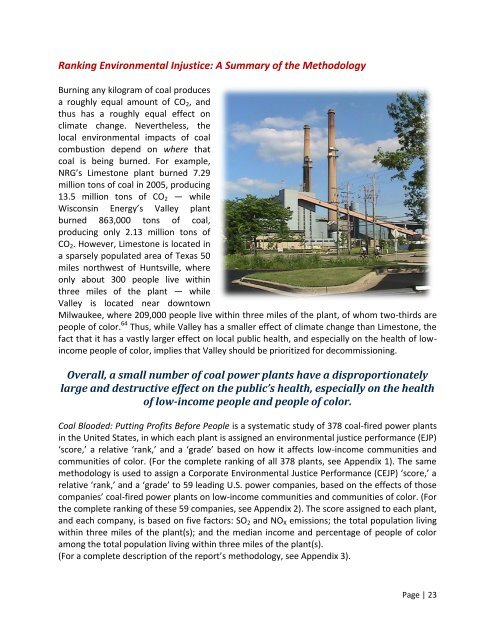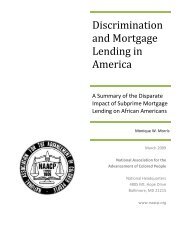Ranking Environmental Injustice: A Summary of the MethodologyBurning any kilogram of coal producesa roughly equal amount of CO 2 , andthus has a roughly equal effect onclimate change. Nevertheless, thelocal environmental impacts of coalcombustion depend on where thatcoal is being burned. For example,NRG’s Limestone plant burned 7.29million tons of coal in 2005, producing13.5 million tons of CO 2 — whileWisconsin Energy’s Valley plantburned 863,000 tons of coal,producing only 2.13 million tons ofCO 2 . However, Limestone is located ina sparsely populated area of Texas 50miles northwest of Huntsville, whereonly about 300 people live withinthree miles of the plant — whileValley is located near downtownMilwaukee, where 209,000 people live within three miles of the plant, of whom two-thirds arepeople of color. 64 Thus, while Valley has a smaller effect of climate change than Limestone, thefact that it has a vastly larger effect on local public health, and especially on the health of lowincomepeople of color, implies that Valley should be prioritized for decommissioning.Overall, a small number of coal power plants have a disproportionatelylarge and destructive effect on the public’s health, especially on the healthof low-income people and people of color.<strong>Coal</strong> <strong>Blooded</strong>: <strong>Putting</strong> <strong>Profits</strong> <strong>Before</strong> <strong>People</strong> is a systematic study of 378 coal-fired power plantsin the United States, in which each plant is assigned an environmental justice performance (EJP)‘score,’ a relative ‘rank,’ and a ‘grade’ based on how it affects low-income communities andcommunities of color. (For the complete ranking of all 378 plants, see Appendix 1). The samemethodology is used to assign a Corporate Environmental Justice Performance (CEJP) ‘score,’ arelative ‘rank,’ and a ‘grade’ to 59 leading U.S. power companies, based on the effects of thosecompanies’ coal-fired power plants on low-income communities and communities of color. (Forthe complete ranking of these 59 companies, see Appendix 2). The score assigned to each plant,and each company, is based on five factors: SO 2 and NO X emissions; the total population livingwithin three miles of the plant(s); and the median income and percentage of people of coloramong the total population living within three miles of the plant(s).(For a complete description of the report’s methodology, see Appendix 3).Page | 23
It is important to note that this report is not a ranking of coal power plants based on the overalltoxicity of their emissions — in other words, the fact that a particular plant receives agrade of “F” does not mean that it is necessarily one of the ‘dirtiest’ coal plantsin the United States. Numerous existing reports and studies (most notably, theEnvironmental Integrity Project’s “Dirty Kilowatts” reports 65 ) score coal power plants basedpurely on the toxicity of each plant’s emissions. This report is an “environmental justiceperformance” ranking—it uses a complex algorithm (See Appendix III), combining levels of SO 2and NO X emissions together with demographic factors, in order to calculate each plant’s score,ranking, and grade.Also, CO 2 emissions were not included as a factor in the rankings. This is for two reasons: (1)unlike pollutants like SO 2 or NO X , there is no viable way of limiting the amount of CO 2 that isemitted when coal is burned, and thus each coal power plant’s CO 2 emissions are simply afunction of the plant’s size; 66 and (2) while CO 2 affects the planet as a whole, SO 2 and NO Xprimarily affect communities in the area surrounding the power plant, making SO 2 and NO Xmore relevant pollutants than CO 2 for the purpose of environmental justice calculations.Finally, the fact that researchers assigned a particular plant a ‘passing’ environmental justiceperformance grade does not suggest that this plant has no detrimental effect on public health,or on low-income communities or communities of color. These grades are relative, and onlyscore individual plants in relation to one another.All coal-fired power plants in the United States are detrimental to publichealth.Thus, a grade of ‘incomplete’ is assigned to plants scoring above C —as it would beunconscionable to assign a grade of A or B to a plant that, while not located in an area that isdensely populated by low-income communities or communities of color, is nonethelessresponsible for causing considerable environmental and public health effects.<strong>Coal</strong> <strong>Blooded</strong> builds on the information first presented in Air of Injustice a 2002 report authoredby the Black Leadership Forum and several other organizations. 67 However, this report differsfrom Air of Injustice in four ways. First, this report provides a detailed ranking of individual coalplants, including commentary from affected populations which are often communities of colorand low income communities that are frequently the voices less seen or heard. Second, thisreport includes income as well as race as a ranking factor. Third, this report ranks thecompanies that own these plants, rather than just the plants themselves; and fourth, thisreport analyzes census-block-level data, which is a smaller-scale than the county-level dataused in Air of Injustice. Census-block-level data consist of the smallest geographic area forwhich the Bureau of the Census collects and tabulates decennial census data, which are formedby streets, roads, railroads, streams and other bodies of water, other visible physical andcultural features, and the legal boundaries shown on Census Bureau maps. 68 Using block-level-Page | 24








